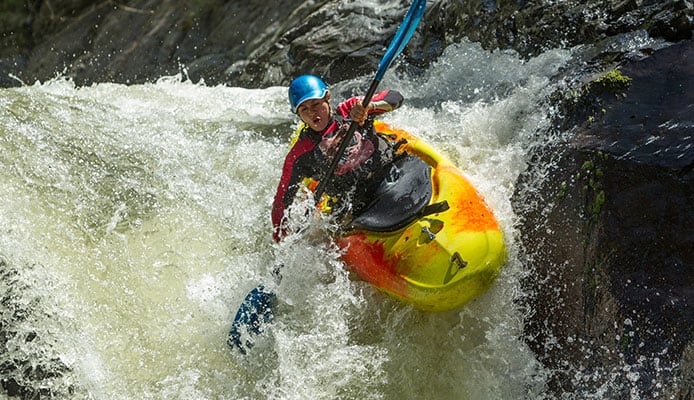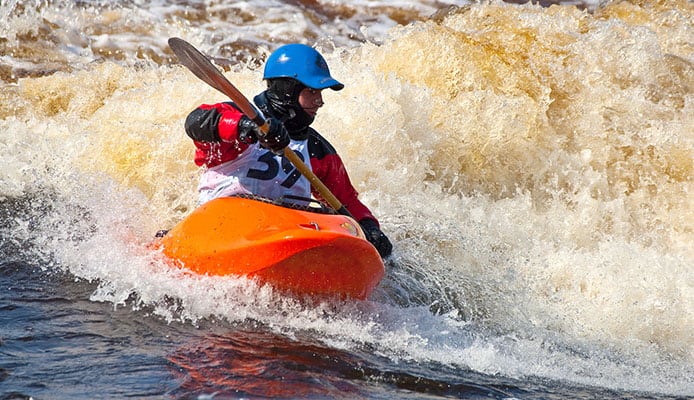
When you go kayaking during the warmer months of the year, you don’t really need to worry much about what you should wear provided that it’s comfortable and gives you enough protection from the sun like wide-brimmed hats and UV protective clothing. Kayaking during the colder seasons though, now that’s when you need to start thinking about what you should wear. Along that line, many kayakers often find themselves torn between wearing a wetsuit vs. a drysuit for kayaking. The truth is that both types of thermal suits have their own pros and cons and are suitable for different kinds of paddling environments. But before we dive into the details about the difference between wetsuit and drysuit and which one you should choose, let’s first take a look at why you’ll need one of these while kayaking during the colder months of the year.
Why do you need a drysuit or a wetsuit anyway?
When you go kayaking during the warmer months of the year, wearing a drysuit or a wetsuit shouldn’t be too much of a concern (though many watersport enthusiasts will still wear a wetsuit regardless of the time of year). However, when kayaking in the winter, wearing a drysuit or a wetsuit is often necessary to avoid the health hazards that the cold weather can bring.
For instance, it is a fact that being exposed to cold waters and temperatures for certain periods (from a few minutes in extreme cold to a few hours in relatively cold conditions) can lead to hypothermia. This happens when the cold environment overwhelms the body’s ability to produce and retain heat. When mild hypothermia sets in, it is normal for paddlers (or any other person) to experience increased muscle rigidity, decreased motor skills, uncontrollable shivering, and slurred speech. It can even affect the paddler’s mental state, leading to confusion, irritability, lethargy, and disorientation. Needless to say, all of these can put a paddler in dangerous, even fatal, situations.
Another thing to keep in mind is the possibility of falling into the cold water while kayaking. One of the goals of many paddlers who go kayaking in the winter is to stay in the kayak; however, there are certain instances when you can take an unexpected dunking which leads to a cold shock. Obviously, sudden immersion in cold water can cause the paddler to experience physiological and psychological issues, affecting their ability to move and think accordingly. At worst, it can lead to cardiac arrest.
For these reasons, paddlers must wear the necessary outfit to prepare them for these scenarios. Kayakers are always advised to dress according to the temperatures and the kind of paddling that they plan to do, and in these cases, wetsuits and drysuits can be of tremendous help. If you’re dressed warm enough, you should be able better endure the cold environments and even swim back to your boat when you go overboard.
Now that we’ve established the importance of wearing a drysuit or a wetsuit, let’s take a look at the difference between the two and some considerations as to which of them should you choose when you go paddling in cold waters.
What is a drysuit?
Kayaking drysuits, as the name suggests, are designed to keep you dry while paddling or doing some other type of watersports like diving, fishing, and others. They are made from waterproof materials like laminated layers of nylon, fabrics coated with vulcanized rubber, and others. They also come with neck, wrist, and sometimes ankle gaskets made from latex, neoprene, or silicone rubber to seal these openings tightly and keep the water from coming in.
A paddling drysuit is designed to fit loosely to give the user a great deal of freedom of movement while paddling, whether that be a kayak, a canoe, or a stand-up paddleboard. The loose fit also gives you more mobility when dinghy sailing or casting a fishing line.
Do note that a drysuit’s ability to keep water out is also one of its biggest issues. Because of the coatings applied to the tightly woven fabric and the sealed openings, it does not only keep water out but also traps moisture, specifically sweat, inside which can make the wearer feel uncomfortable. Fortunately, there are drysuits nowadays that are made with breathable materials but are still completely waterproof. These will, of course, cost more than your ordinary drysuit, but many paddlers will agree that the added comfort is worth the additional expense.
How does a drysuit keep you warm?
A common misconception is that drysuits are worn to keep people warm. Although drysuits offer a certain amount of insulation, it should be noted that drysuits merely act as an outer layer and isn’t warm in themselves. To stay warm, you need to wear a base layer and a mid-layer underneath your drysuit.
Experts recommend wearing base layers made from wool or synthetic fabrics to help move sweat away from the skin and keep it dry. A mid-layer, on the other hand, is a warm garment like fleece. In any case, you’ll want to avoid using cotton fabrics for your base and mid-layers since they absorb moisture and will leave you feeling wet or damp. Also, you’ll need to vary the number and thickness of your base and mid-layers depending on how cold the weather is.
What are the advantages of a drysuit?
The biggest advantage of a drysuit is that it will keep you completely dry while paddling. You don’t have to worry about getting wet from splashing water. You don’t even have to worry about water flowing down your arms as they drip from dripping from your hands when you lift your kayak paddle out of the water. More importantly, when you do get into the water, you can be sure that you’ll remain completely dry and warm.
Another advantage is that you can regulate the temperature inside your drysuit by modifying the number and thickness of your base and mid-layers. Simply add or remove layers as you see fit. Lastly, it is much easier to get in and out of a drysuit than a wetsuit, especially when the wetsuit is soaking wet and is hugging your skin.
You might also like:
What is a wetsuit?
One big difference between wetsuit and drysuit is that unlike drysuits, kayaking wetsuits are mostly designed to keep you warm and not dry. Yes, you will get wet while wearing a wetsuit (hence the name), but you’ll remain warm at the same time. Mostly made from neoprene, wetsuits are made with a closed-cell foam material, which is filled with thousands of tiny gas bubbles trapped within the structure. Wetsuits are available in a variety of thicknesses, and the thicker the wetsuit, the more insulation it provides.
How does a wetsuit keep you warm?
Unlike drysuits, wetsuits will allow a certain amount of water to enter through them. Afterward, the gas bubbles in the wet suit trap the water inside so it doesn’t flow out. The heat emanating from your body will then heat the water trapped between your skin and the wetsuit inner layer. The heated water then serves as your insulation and keeps you warm (think of it as being submerged in a hot tub). With that in mind, wetsuits are mostly recommended for paddlers who plan on getting wet like those going on whitewater kayak adventures or those riding their touring kayaks across the waves in coastal areas.
That said, always choose a wetsuit that fits close to your body. A loose-fitting wetsuit will let water flow in and out easily, which means that cold water will continuously flow into the wetsuit and the heated water out of it. This will lead to wasted energy as your body will need to heat the cold water again.
What are the advantages of a wetsuit?
An advantage of wetsuit over drysuits is that it comes in a variety of styles that allow you to cover as much or as little of your body as you need depending on the temperature of the water and the environment. There are full wetsuits that cover you completely from your neck down to your ankles (perfect for cold weathers), and there are short johns that only cover your torso and your thighs leaving your arms and lower legs exposed (great for warmer temperatures).
Another advantage of wetsuits over drysuits is that they allow for better movement and mobility. Since they fit close to your body, you will feel like you’re wearing ordinary clothes, unlike those baggy drysuits which can feel like you’re wearing thick, heavy, and oversized overalls.
Globo Surf Overview
So which one should you choose? Should you go for a drysuit or would a wetsuit be the better option? To settle this debate about wetsuit vs. drysuit for kayaking, the best answer would be to choose a drysuit if you want to stay completely dry (like when you go kayak fishing in the winter), and go for a wetsuit if you’re okay with getting wet but still want to keep warm (like when you go whitewater kayaking).
More Kayak Gear Guides:
More Kayak Gear Reviews:
- Kayak Coolers
- Kayak Drysuits
- Kayaking Gloves
- Kayak Helmets
- Kayak Wetsuits
- Drysuit Undergarments
- Kayak Shoes
- Kayak Paddles
- Kayak Compasses
- Kayak GPS


